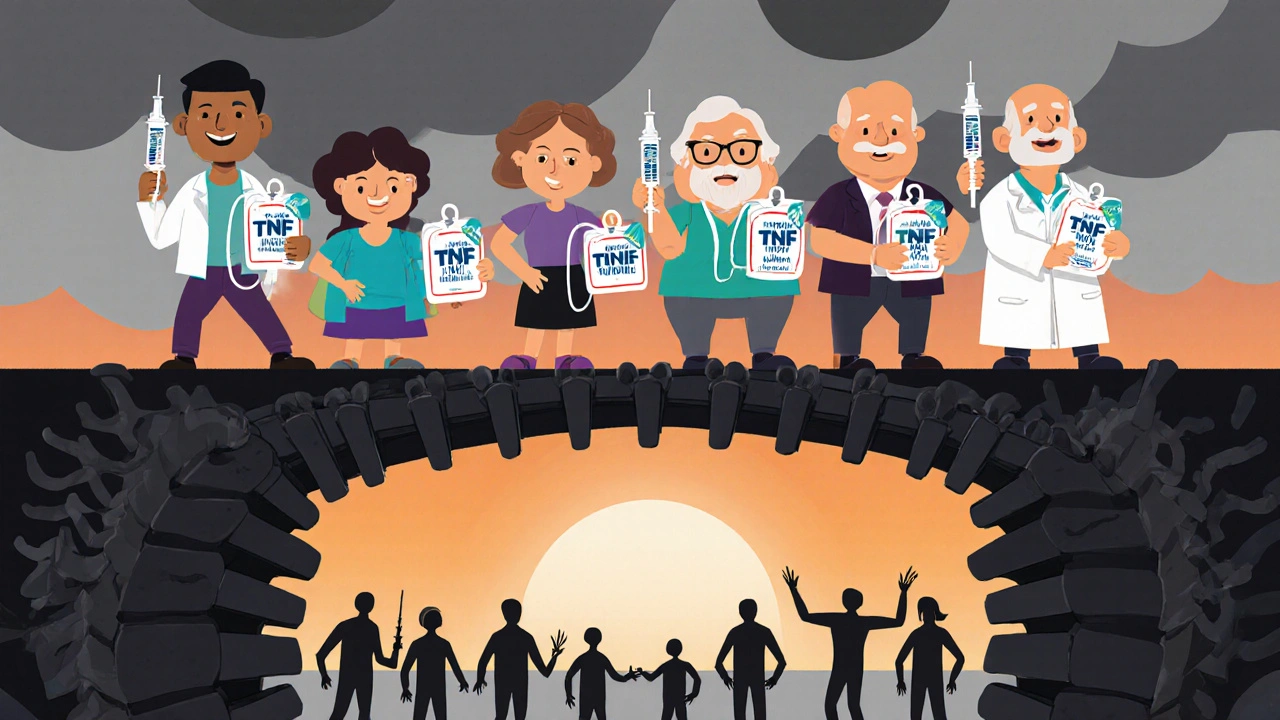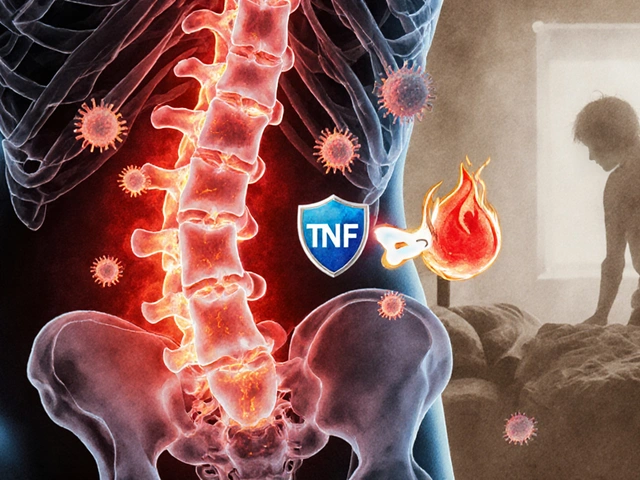What Is Ankylosing Spondylitis?
Ankylosing spondylitis (AS) isn’t just back pain. It’s a chronic autoimmune disease that attacks the spine and sacroiliac joints, causing inflammation so severe it can fuse vertebrae together over time. People with AS often wake up stiff as a board, with pain that doesn’t improve with rest - it gets worse. Morning stiffness can last over an hour, and simple movements like bending or twisting become painful challenges. Unlike regular back pain from lifting or sitting too long, AS inflammation lingers for months, even years, and doesn’t respond to typical remedies.
This disease doesn’t just affect the spine. It can also inflame the hips, shoulders, heels, and even the eyes. About 30% of people with AS develop uveitis - painful red eyes that need immediate treatment. The root cause? An overactive immune system targeting healthy tissue. Scientists know HLA-B27 is a major genetic risk factor - if you carry this gene, your chance of developing AS jumps from less than 1% in the general population to 5-6%. But not everyone with HLA-B27 gets AS, which means environment and other genes play a role too.
How Inflammation Turns Into Bone Fusion
The damage from AS happens in three stages. First, inflammation flares up in the joints where ligaments attach to bone - called entheses. This is where you feel the sharpest pain. The body sends immune cells and cytokines like TNF-alpha to fight what it thinks is an infection. But there’s no infection. The immune system is just misfiring.
Second, that constant inflammation eats away at bone. Tiny cracks form in the spine and sacroiliac joints. On MRI scans, this shows up as bright spots - a clear sign of active disease. If left untreated, the body tries to repair the damage by laying down new bone. That’s the third stage: abnormal bone growth. Over time, these new bone deposits fuse vertebrae together, creating a rigid, inflexible spine. This is called “bamboo spine” - a term doctors use because the spine looks like a bundle of bamboo stalks on X-rays.
The scary part? Once fusion happens, it’s permanent. No drug can undo it. That’s why early treatment is critical. The goal isn’t just to reduce pain - it’s to stop the inflammation before it locks your spine in place.
Why TNF Inhibitors Are a Game Changer
Before TNF inhibitors, treatment options were limited. NSAIDs like ibuprofen or naproxen helped with pain and stiffness for some, but they didn’t stop the disease. Physical therapy kept people mobile, but it couldn’t slow fusion. Then, in the early 2000s, everything changed.
TNF-alpha is the main driver of inflammation in AS. It’s like the spark that keeps the fire burning. TNF inhibitors block this protein - one molecule at a time. By doing that, they calm the immune system’s attack on the spine and joints. Within weeks, patients report less pain, less stiffness, and more energy. MRI scans show inflammation dropping by nearly 60% after just six months of treatment.
Five TNF inhibitors are approved for AS in the U.S.: infliximab, etanercept, adalimumab, certolizumab, and golimumab. They’re not all the same. Infliximab is given through an IV every 4 to 8 weeks at a clinic. The others are self-injected under the skin - weekly, every other week, or monthly. Adalimumab (Humira) and etanercept (Enbrel) are the most commonly used because they’re easier to manage at home. Studies show 60% of patients see at least a 20% improvement in symptoms within 12 weeks. For nearly half, the improvement hits 40% or more - enough to return to work, exercise, or play with kids again.
Who Benefits Most From TNF Inhibitors?
Not everyone with AS responds the same way. The best candidates have three things: high disease activity, elevated inflammation markers, and early diagnosis. Doctors use the BASDAI score to measure this. If your score is 4 or higher on a scale of 10 - and you’ve tried NSAIDs at full dose for at least four weeks without relief - you’re likely a good fit for TNF inhibitors.
Blood tests matter too. If your CRP (C-reactive protein) is above 5 mg/L or your ESR (sedimentation rate) is over 20 mm/h, your chances of responding well jump significantly. One study found that 81% of patients with both high CRP and high SAA (serum amyloid A) had a strong response to TNF blockers. Younger patients - under 35 - and those with shorter disease duration (under 7 years) also respond better. The earlier you start, the more likely you are to avoid permanent damage.
On the flip side, older patients with long-standing disease, low inflammation markers, or fused spines on X-rays tend to see less benefit. That doesn’t mean they shouldn’t try - but it helps set realistic expectations.

Real Results From Real Patients
One patient from Sydney, 31, started on adalimumab after two years of unrelenting back pain. His BASDAI was 8.5. Within six weeks, he could get out of bed without help. By four months, he was swimming again. “I didn’t realize how much I missed moving freely,” he said.
Another, 45, switched from etanercept to infliximab after losing effectiveness. His morning stiffness dropped from 90 minutes to 15. He’s been on TNF inhibitors for 11 years. “I’m not cured,” he says. “But I’m not disabled either.”
Survey data from the Spondylitis Association of America shows 78% of users report “substantial improvement.” For 62%, morning stiffness shrank from over an hour to under 30 minutes. Most notice changes within 2-3 doses - but full benefits take up to 12 weeks. That’s why patience matters. It’s not a quick fix. It’s a long-term reset of your immune system.
Side Effects and Risks - What You Need to Know
TNF inhibitors are powerful, and that means they come with risks. The biggest concern? Infections. Because they suppress part of your immune system, you’re more vulnerable to serious bugs like tuberculosis, pneumonia, or fungal infections. That’s why everyone gets tested for TB before starting. If you’ve had TB in the past, you’ll need preventive treatment first.
Other common issues include injection site reactions - redness, itching, or swelling - which affect about 19% of users. Upper respiratory infections and headaches are also frequent, but usually mild. Serious skin reactions, like psoriasis or lupus-like symptoms, happen in about 15% of cases. Some people develop new psoriasis after starting etanercept - which is ironic, since TNF inhibitors are used to treat psoriasis too. In those cases, switching to another TNF blocker often helps.
Heart failure and nervous system disorders like multiple sclerosis are rare, but they’re serious enough that the FDA requires a black box warning on all TNF inhibitors. If you have a history of heart disease or neurological issues, your doctor will weigh risks carefully.
Discontinuation rates are around 15%. The most common reason? Loss of effectiveness. About 35% of patients eventually stop responding. Others stop because they go into remission and want to try going off - which sometimes works, but often doesn’t. Only 10-15% stay off long-term without flare-ups.
How TNF Inhibitors Compare to Other Treatments
There are newer drugs now - IL-17 inhibitors like secukinumab and ixekizumab. They work on a different part of the immune system. In head-to-head trials, they match TNF inhibitors in effectiveness. About 56% of patients on secukinumab hit ASAS40 improvement (a 40% symptom reduction) compared to 53% on adalimumab.
But TNF inhibitors still lead in real-world use. Why? They’ve been around longer. We know their safety profile better. Over 20 years of data show they reduce radiographic progression by 50-60% if started early. IL-17 inhibitors don’t have that kind of long-term track record yet.
Biosimilars are changing the game too. Amjevita, a cheaper version of Humira, now makes up over a third of the adalimumab market. Prices have dropped 15-20%, making treatment more accessible. In countries with universal healthcare, like the UK and Germany, 65-70% of eligible AS patients get TNF inhibitors. In the U.S., it’s closer to 45-50% - mostly because of insurance hurdles.

Getting Started With TNF Inhibitors
If your doctor recommends a TNF inhibitor, here’s what to expect:
- Screening first: TB test, hepatitis B/C check, and heart function review.
- Choose your drug: Talk about lifestyle. Do you hate clinics? Then avoid infliximab. Prefer monthly shots? Golimumab might be best.
- Learn to inject: For subcutaneous drugs, you’ll get trained. Most people master it after one or two sessions. Support lines and apps help with reminders and tracking.
- Start slow: You won’t feel better overnight. Give it 8-12 weeks. Keep a symptom diary.
- Monitor regularly: Blood tests every 3-6 months. Watch for signs of infection - fever, cough, unexplained fatigue.
Don’t skip physical therapy. Exercise - especially swimming and yoga - keeps your spine flexible. TNF inhibitors stop the damage. Movement keeps you functional.
What’s Next for AS Treatment?
Research is moving fast. Scientists are now looking at gene patterns and protein markers to predict who will respond to which drug - before they even start. Early data suggests certain HLA-B27 subtypes respond better to TNF blockers than others.
Next-gen drugs are being tested to block only the harmful form of TNF (TNFR1) while leaving the protective version (TNFR2) alone. That could mean fewer side effects. Phase II trials start in 2024.
For now, TNF inhibitors remain the gold standard. Even with newer options, they’ll still be used by 60-65% of AS patients through 2030, according to rheumatology experts. Why? Because they work. They save mobility. They save lives.
Final Thoughts
Ankylosing spondylitis doesn’t have to mean a life of pain and stiffness. TNF inhibitors don’t cure it - but they give you back control. If you’ve been told your back pain is “just aging” or “poor posture,” that’s not true. This is a real disease with real treatments. If you’re struggling, ask your doctor about TNF inhibitors. Don’t wait until your spine fuses. Early action changes everything.


Edward Weaver
November 11, 2025 AT 08:42Lexi Brinkley
November 13, 2025 AT 01:26Erika Puhan
November 14, 2025 AT 09:06Kelsey Veg
November 15, 2025 AT 04:56Alex Harrison
November 16, 2025 AT 13:08Jay Wallace
November 18, 2025 AT 10:44Alyssa Fisher
November 19, 2025 AT 13:45Alyssa Salazar
November 20, 2025 AT 07:21Beth Banham
November 21, 2025 AT 21:59Brierly Davis
November 23, 2025 AT 09:39Jim Oliver
November 24, 2025 AT 21:09William Priest
November 25, 2025 AT 11:12Ryan Masuga
November 27, 2025 AT 05:20Jennifer Bedrosian
November 29, 2025 AT 04:39Lashonda Rene
November 29, 2025 AT 08:26